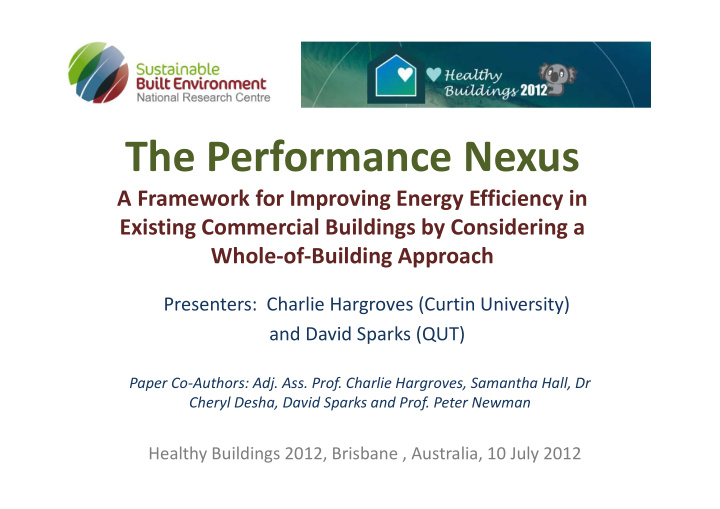



The Performance Nexus A Framework for Improving Energy Efficiency in Existing Commercial Buildings by Considering a Whole ‐ of ‐ Building Approach Presenters: Charlie Hargroves (Curtin University) and David Sparks (QUT) Paper Co ‐ Authors: Adj. Ass. Prof. Charlie Hargroves, Samantha Hall, Dr Cheryl Desha, David Sparks and Prof. Peter Newman Healthy Buildings 2012, Brisbane , Australia, 10 July 2012
Senior Project Members Prof. Peter Newman (Curtin) Prof. Bill Duncan (QUT) Project Leaders Research Team Members Charlie Hargroves Dr Cheryl Desha Samantha Hall David Sparks Kuntul Datta (Curtin) (QUT) (Curtin) (QUT) (Curtin)
Understanding the Performance of Existing Office Buildings to inform Energy Reduction Initiatives The focus of this project is to provide a low complexity guiding framework to assist efforts to understand a range of factors related to the performance of commercial buildings and support efforts to undertake upgrades to existing office buildings. 5
Understanding the Performance of Existing Office Buildings to inform Energy Reduction Initiatives Design elements can impact the indoor environment, occupant experience and can dictate what building management and tenant agreement options are available. Design elements include features such as HVAC systems, lighting/ day ‐ lighting methods, building materials and layout.
Understanding the Performance of Existing Office Buildings to inform Energy Reduction Initiatives Indoor environment quality is influenced by the design elements and can have a significant impact on the health and productivity of building occupants. Building management practices influence IEQ and tenant agreements can be used to influence IEQ outcomes.
Understanding the Performance of Existing Office Buildings to inform Energy Reduction Initiatives The experience of occupants related to the building’s indoor environment, design elements, and building management practices provides insight into the influence of the office environment on respondents’ perceived productivity.
Understanding the Performance of Existing Office Buildings to inform Energy Reduction Initiatives Building management can have a profound impact on the overall functioning of the building, impacting the indoor environment and occupant experience.
Understanding the Performance of Existing Office Buildings to inform Energy Reduction Initiatives A range of existing legal instruments that can influence the performance of commercial buildings and underpin greater energy conservation and improved IEQ across the full lifecycle, including design, operation and management, and demolition.
Next Steps...
Recommend
More recommend